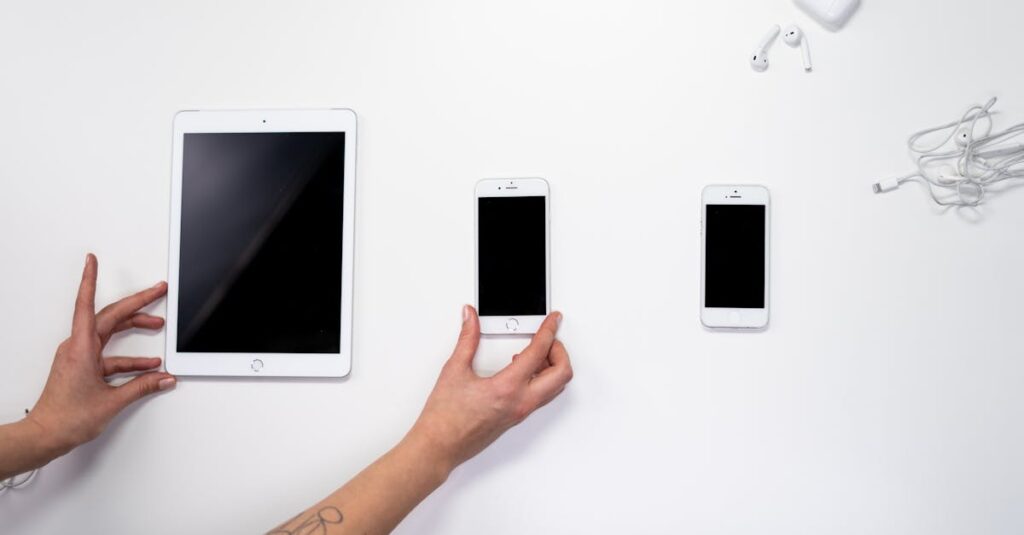Table of Contents
ToggleWhen it comes to iPhones, the debate over whether to keep the lock sound on or off can feel as intense as choosing between pizza toppings. Some swear by the satisfying click that signals their device is securely locked, while others prefer the stealth mode that keeps their phone’s antics under wraps. It’s a classic case of personal preference, but the implications can be more significant than one might think.
Imagine this: you’re in a quiet meeting, and your iPhone decides to announce its presence with a loud click. Suddenly, all eyes are on you, and you’re the unwitting star of an awkward moment. On the flip side, turning it off means you might miss that crucial confirmation that your phone is locked. So, should the lock sound be on or off? Let’s dive into the pros and cons and help you make the right choice for your lifestyle.
Overview of Lock Sound on iPhone
Lock sound on an iPhone serves as an audio confirmation that the device has successfully locked. Many users appreciate this feedback, as it provides reassurance that their phone is secure. In contrast, some prefer silence, especially in quiet environments.
Turning on the lock sound creates an audible click, which can draw attention in public spaces. For instance, during meetings or in libraries, silence may be more appropriate to avoid distractions.
Adjusting the lock sound setting is easy. Users can navigate to Settings, select Sounds & Haptics, and toggle the Lock Sound option on or off. This flexibility allows individuals to choose based on their preferences or surrounding circumstances.
Some users report feeling more in control when they hear the lock sound. They find that it confirms their action without needing to check the screen. Conversely, others claim the absence of sound promotes a more discreet experience, particularly in professional settings.
Understanding personal lifestyle plays a vital role in this choice. Users focused on privacy may opt for a silent device, whereas those less concerned about noise may enjoy the auditory confirmation. Ultimately, the decision hinges on individual habits and environments, making it essential for users to assess their needs when deciding about the lock sound feature.
Pros of Keeping Lock Sound On
Keeping the lock sound on provides valuable benefits for users. Many find that the auditory cue enhances their interaction with the device.
Enhanced Feedback
Audible confirmation makes it clear when the iPhone locks. Users can feel confident that their action succeeded without needing to check the screen. This sound offers immediate reassurance, helping users stay engaged. Enhanced feedback can be particularly useful in busy environments where visual checks aren’t feasible.
Security Benefits
The lock sound adds a layer of security to device usage. An audible click alerts users to any unauthorized attempts to access their phones. This feature can deter potential intruders who might hesitate if they hear the locking mechanism. Additionally, users can quickly identify if their phone isn’t securely locked, promoting better habits regarding device security.
Cons of Keeping Lock Sound On
Keeping the lock sound on presents some drawbacks for iPhone users to consider. Some individuals find the noise distracting, especially in quiet settings. Discreet environments like libraries or meetings often amplify these sounds. Such distractions might disrupt the focus of not only the user but also those nearby.
Battery consumption is another concern. While the lock sound uses minimal power, every little bit adds up over time. Frequent activation of the lock mechanism can lead to a slight increase in energy usage. Users who prioritize battery life often aim to minimize unnecessary sounds. Therefore, considering both distraction and battery consumption encourages users to weigh the pros and cons of the lock sound feature.
Pros of Turning Lock Sound Off
Turning off the lock sound provides several advantages for users. Emphasizing quietness can significantly enhance the user experience in various situations.
Increased Quietness
Users appreciate reduced noise levels in environments that require concentration. Quiet settings like libraries, meetings, or during meditation benefit from a silent device, allowing individuals to focus without distractions. Noticing the subtle vibrations or visual confirmations on the screen serves as an effective alternative. Reducing unwanted sound proves especially valuable for those who frequently find themselves in professional or multi-person settings. A peaceful atmosphere cultivates better engagement and productivity.
Longer Battery Life
Minimizing sound can also contribute to battery longevity. While the energy consumption of the lock sound remains minimal, disabling it helps decrease overall power usage. Users striving for maximum battery life appreciate every small change that prolongs device performance. Ignoring unnecessary audio cues supports extended functionality during busy days. This adjustment especially benefits those who rely on their phones throughout the day without frequent recharging options. Prolonging battery life becomes essential for users on the go.
Cons of Turning Lock Sound Off
Turning off the lock sound has several drawbacks that users should consider.
Lack of Feedback
Users may experience a loss of feedback when the lock sound is disabled. Auditory confirmation reinforces the action of locking the device, providing assurance that it’s secure. Many individuals rely on this sound for interactive cues, making it feel tangible. Without it, users might have to check their screens more frequently, leading to interruptions. The click sound serves as a reliable signal, especially in busy environments, reducing uncertainty during multitasking. Ultimately, the absence of sound might hinder the overall user experience, affecting how confidently they manage their devices.
Deciding whether to keep the lock sound on or off on an iPhone ultimately depends on individual preferences and lifestyle. Users valuing audio feedback may appreciate the reassurance it provides, while those in quieter environments might find it distracting.
Adjusting the setting is simple and allows for flexibility based on specific situations. Whether prioritizing discretion in meetings or enjoying the sound’s confirmation of security, it’s essential for users to reflect on their habits. This choice can enhance their overall experience with the device, ensuring it aligns with their daily needs.




